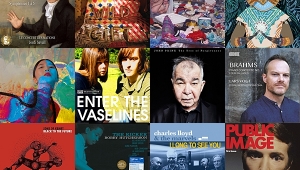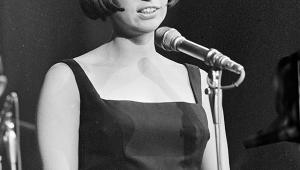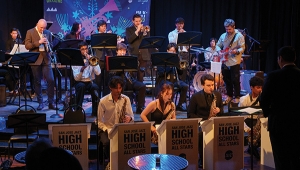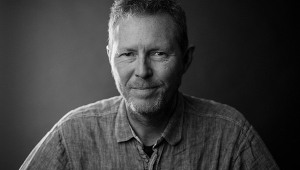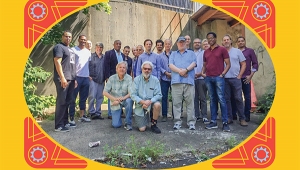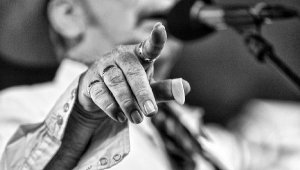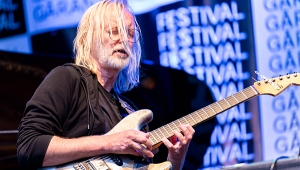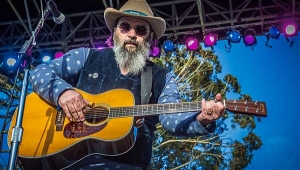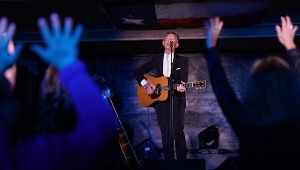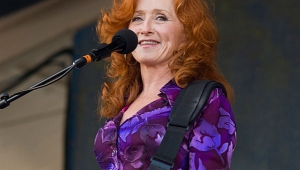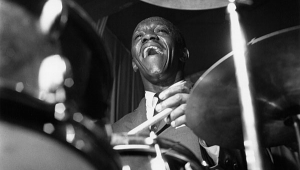| Columns Retired Columns & Blogs |
The Unmaking of Elvis Presley: New Reissues 1960-1972 Page 2
Four new Jorgensen/Semon-produced Elvis reissues—Elvis is Back, Such a Night, Tomorrow is a Long Time, and Burning Love—attempt, to varying degrees, to be "albums that never were." All of the songs on each album, including singles, were recorded around the same time, usually in the same studio with the same musicians; had the recording philosophy then been what it is today, these tracks would probably have ended up on the same album anyway.
Assembling tracks cut at the same time was a relatively easy decision. Deciding on the mix was another story.
 "In the first three cases [Elvis is Back, Such a Night, Tomorrow is a Long Time] we've gone back, not to the master tapes, but to the original session tapes and faithfully remixed from those, A/B'ing from the masters to re-create the same ambience," Jorgensen says "In Nashville at that time you had two machines running: a three-track machine for safety and an on-the-spot mixdown two-track in stereo. The engineers got the mix on the fly. They then cut the master takes out of the reel and assembled them on a master reel, which was then shipped to RCA in New York.
"In the first three cases [Elvis is Back, Such a Night, Tomorrow is a Long Time] we've gone back, not to the master tapes, but to the original session tapes and faithfully remixed from those, A/B'ing from the masters to re-create the same ambience," Jorgensen says "In Nashville at that time you had two machines running: a three-track machine for safety and an on-the-spot mixdown two-track in stereo. The engineers got the mix on the fly. They then cut the master takes out of the reel and assembled them on a master reel, which was then shipped to RCA in New York.
"Today, because his catalog has been overused and the master tapes have been played too many times, there are dropouts, clicks, etc. In some cases the master is gone and you're working with a second- or third-generation master.
"Also in those days—and Motown is probably the prime example of this—they compressed the stuff, EQ'd the stuff for the radio, so it would jump at you. We also know that Elvis approved every master, and often later complained that the music had been compressed too hard—that after it had left him, they had lifted his voice out of the background music and brought it forward. Because we can't talk to the artist, we've gone back and read his correspondence, which, while not a religion, is a guideline."
In 1960, Elvis Presley returned to RCA's then new Quonset hut studio B in Nashville for the first time in two years, to begin work on his "comeback" album. The music from those two sessions, in March and April—and the two Memphis sessions in early 1969, after the "'68 Comeback Special"—are generally considered to be the cream of his post-army recordings.
The official album from the '60 sessions, Elvis is Back, remains one of his finest—one that nearly equals the vibrance of his Sun and early RCA records. Its success is due not only to a collection of above-average songs, but to Elvis's wonderfully supple and expressive singing. The new RCA reissue adds the six songs (originally released on three singles) that came from these sessions but were not included on the original album. The original 12-track album in the Living Stereo masters is available as a gold disc on the DCC label (DCCZS-1111).
 Elvis is Back launched six Top 40 hits, three of which went to #1. The chart-toppers make a curious trio. The first, "Stuck On You," which hit the streets less than a month after it was recorded, is an Otis Blackwell number that revisits the fertile vein first tapped in "All Shook Up." "It's Now or Never," which consists of new lyrics appended to "O Sole Mio," is a vocal tour de force in a performance later overshadowed by the song's role as one of the overblown melodramas in Elvis's increasingly sad Las Vegas extravaganzas. The most resilient hit of the three is "Are You Lonesome Tonight?," a 1927 hit that Colonel Parker asked Elvis to record because it was his wife, Marie's, favorite song. It's one of few #1 1960's top 40 hits ever by anyone to include a lengthy spoken narration.
Elvis is Back launched six Top 40 hits, three of which went to #1. The chart-toppers make a curious trio. The first, "Stuck On You," which hit the streets less than a month after it was recorded, is an Otis Blackwell number that revisits the fertile vein first tapped in "All Shook Up." "It's Now or Never," which consists of new lyrics appended to "O Sole Mio," is a vocal tour de force in a performance later overshadowed by the song's role as one of the overblown melodramas in Elvis's increasingly sad Las Vegas extravaganzas. The most resilient hit of the three is "Are You Lonesome Tonight?," a 1927 hit that Colonel Parker asked Elvis to record because it was his wife, Marie's, favorite song. It's one of few #1 1960's top 40 hits ever by anyone to include a lengthy spoken narration.
But, as is often the case with anyone, it's the non-single tracks on Elvis is Back that make the album great. He nails the Lowell Fulson blues, "Reconsider Baby." Another '50s rock'n'roll hit, the joyously lewd (by 1960 standards) "Such a Night," had been a hit for Clyde McPhatter—how much Elvis enjoyed recording the song is obvious from his war whoop at the end. Finally, accompanied by just a standup bass and two drummers, he whispers his way through "Fever," in the process steamrollering previous hit versions by Little Willie John and Peggy Lee. If there's anything transcendent about Elvis is Back, particularly in this new 18-track version, it's Elvis's evident growth as a singer. For the first time there are flecks hints of what he would be for the rest of his career: an expressive interpreter of towering ballads and other, softer pop blockbusters.
Some of that growth can be heard on the latest installment of RCA's Essential Elvis series, Such a Night, which covers Nashville recordings made in RCA's famous Studio B between 1960 and 1964. Recordings made during this period were used until 1965, providing both singles and album tracks on such collections as Elvis is Back, His Hand in Mine, Something for Everybody, Pot Luck, and Elvis for Everyone! Some of the earliest recorded were the last released. He would not record fresh non-soundtrack studio material—except for the gospel music on How Great Thou Art—until 1966.
- Log in or register to post comments
